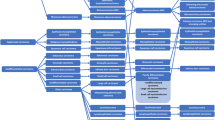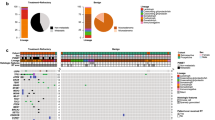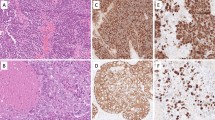Abstract
Cribriform adenocarcinoma of the salivary gland (CASG) is an entity that is currently classified under polymorphous adenocarcinoma (PAC), cribriform subtype per the 2022 WHO classification of head and neck tumours. There is debate about whether CASG should be considered a separate diagnostic entity, as CASG differs from conventional PAC in anatomic site, clinical behaviors, and molecular patterns. Herein we describe a challenging and unique case which shares histologic and behavioral features between CASG and conventional PAC with a YLPM1::PRKD1 rearrangement not previously reported in the literature.


Similar content being viewed by others
Data and Materials Availability
Not applicable.
References
Hahn E, Xu B, Katabi N et al (2023) Comprehensive molecular characterization of polymorphous adenocarcinoma, cribriform subtype: identifying novel fusions and fusion partners. Mod Pathol 36(11):100305. https://doi.org/10.1016/j.modpat.2023.100305
WHO Classification of Tumours Editorial Board (2022) WHO classification of tumours series. Head and neck tumours, vol 9, 5th edn. International Agency for Research on Cancer, Lyon. https://publications.iarc.fr
Katabi N, Xu B (2021) Polymorphous adenocarcinoma. Surg Pathol Clin 14(1):127–136. https://doi.org/10.1016/j.path.2020.09.011
Ziegler S, Eiseler T, Scholz RP, Beck A, Link G, Hausser A (2011) A novel protein kinase D phosphorylation site in the tumor suppressor Rab interactor 1 is critical for coordination of cell migration. Mol Biol Cell 22(5):570–580. https://doi.org/10.1091/mbc.E10-05-0427
Storz P, Toker A (2003) Protein kinase D mediates a stress-induced NF-kappaB activation and survival pathway. EMBO J 22(1):109–120. https://doi.org/10.1093/emboj/cdg009
Ha CH, Wang W, Jhun BS et al (2008) Protein kinase D-dependent phosphorylation and nuclear export of histone deacetylase 5 mediates vascular endothelial growth factor-induced gene expression and angiogenesis. J Biol Chem 283(21):14590–14599. https://doi.org/10.1074/jbc.M800264200
Harikumar KB, Kunnumakkara AB, Ochi N et al (2010) A novel small-molecule inhibitor of protein kinase D blocks pancreatic cancer growth in vitro and in vivo. Mol Cancer Ther 9(5):1136–1146. https://doi.org/10.1158/1535-7163.MCT-09-1145
Andreasen S, Melchior LC, Kiss K et al (2018) The PRKD1 E710D hotspot mutation is highly specific in separating polymorphous adenocarcinoma of the palate from adenoid cystic carcinoma and pleomorphic adenoma on FNA. Cancer Cytopathol 126(4):275–281. https://doi.org/10.1002/cncy.21959
Alliance of Genome Resources Consortium (2022) Harmonizing model organism data in the Alliance of Genome Resources. Genetics https://doi.org/10.1093/genetics/iyac022
De Luca P, Tassone D, de Campora L et al (2022) Cribriform adenocarcinoma of the tongue and minor salivary glands: a systematic review of an uncommon clinicopathological entity. Eur Arch Otorhinolaryngol 279(6):2719–2725. https://doi.org/10.1007/s00405-021-07140-6
Funding
This research received no specific funding.
Author information
Authors and Affiliations
Contributions
M.M-L and M.R. wrote the main manuscript text. M.R. and M.O. provided the pathology diagnoses. M.C. provided the clinical information. All authors reviewed the manuscript.
Corresponding author
Ethics declarations
Conflict of interest
The authors of this manuscript have indicated that they have no conflicts of interest that relate to the content of this manuscript.
Ethical Approval
Not applicable.
Additional information
Publisher's Note
Springer Nature remains neutral with regard to jurisdictional claims in published maps and institutional affiliations.
Rights and permissions
About this article
Cite this article
Miyakawa-Liu, M., Ozawa, M.G., Chen, M. et al. A Novel Gene Fusion YLPM1::PRKD1 Identified in a Cribriform Subtype of Polymorphous Adenocarcinoma. Head and Neck Pathol 18, 43 (2024). https://doi.org/10.1007/s12105-024-01648-z
Received:
Accepted:
Published:
DOI: https://doi.org/10.1007/s12105-024-01648-z




